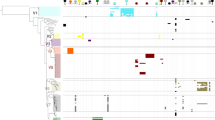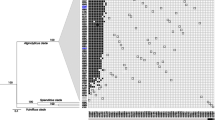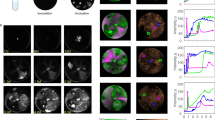Abstract
Bacterial infections are the second largest cause of mortality in shrimp hatcheries. Among them, bacteria from the genus Vibrio constitute a major threat. As the use of antibiotics may be ineffective and banned from the food sector, alternatives are required. Historically, phage therapy, which is the use of bacteriophages, is thought to be a promising option to fight against bacterial infections. However, as for antibiotics, resistance can be rapidly developed. Since the emergence of resistance is highly undesirable, a formal characterization of the dynamics of its acquisition is mandatory. Here, we explored the co-evolutionary dynamics of resistance between the bacteria Vibrio sp. CV1 and the phages V1G, V1P1, and V1P2. Single-phage treatments as well as a cocktail composed of the three phages were considered. We found that in the presence of a single phage, bacteria rapidly evolved resistance, and the phages decreased their infectivity, suggesting that monotherapy may be an inefficient treatment to fight against Vibrio infections in shrimp hatcheries. On the contrary, the use of a phage cocktail considerably delayed the evolution of resistance and sustained phage infectivity for periods in which shrimp larvae are most susceptible to bacterial infections, suggesting the simultaneous use of multiple phages as a serious strategy for the control of vibriosis. These findings are very promising in terms of their consequences to different industrial and medical scenarios where bacterial infections are present.




Similar content being viewed by others
References
Bostock J, McAndrew B, Richards R, Jauncey K, Telfer T, Lorenzen K, Little D, Ross L, Handisyde N, Gatward I, Corner R (2010) Aquaculture: global status and trends. Phil Trans R Soc B Biol Sci 365:2897–2912. doi:10.1098/rstb.2010.0170
Defoirdt T, Sorgeloos P, Bossier P (2011) Alternatives to antibiotics for the control of bacterial disease in aquaculture. Curr Opin Microbiol 14:251–258. doi:10.1016/j.mib.2011.03.004
Gómez G, Balcázar J, Ma S (2007) Probiotics as control agents in aquaculture. J Ocean Univ China (English Edition) 6:76–79. doi:10.1007/s11802-007-0076-8
Defoirdt T, Boon N, Sorgeloos P, Verstraete W, Bossier P (2007) Alternatives to antibiotics to control bacterial infections: luminescent vibriosis in aquaculture as an example. Trends Biotechnol 25:472–479. doi:10.1016/j.tibtech.2007.08.001
McPhearson RM, DePaola A, Zywno SR, Motes ML Jr, Guarino AM (1991) Antibiotic resistance in Gram-negative bacteria from cultured catfish and aquaculture ponds. Aquaculture 99:203–211. doi:10.1016/0044-8486(91)90241-x
Miranda CD, Zemelman R (2002) Bacterial resistance to oxytetracycline in Chilean salmon farming. Aquaculture 212:31–47. doi:10.1016/s0044-8486(02)00124-2
Breitbart M, Salamon P, Andresen B, Mahaffy JM, Segall AM, Mead D, Azam F, Rohwer F (2002) Genomic analysis of uncultured marine viral communities. Proc Natl Acad Sci 99:14250–14255. doi:10.1073/pnas.202488399
Hambly E, Suttle CA (2005) The viriosphere, diversity, and genetic exchange within phage communities. Curr Opin Microbiol 8:444–450. doi:10.1016/j.mib.2005.06.005
Weinbauer MG (2004) Ecology of prokaryotic viruses. FEMS Microbiol Rev 28:127–181. doi:10.1016/j.femsre.2003.08.001
Housby JN, Mann NH (2009) Phage therapy. Drug Discov Today 14:536–540
Hanlon GW (2007) Bacteriophages: an appraisal of their role in the treatment of bacterial infections. Int J Antimicrob Agents 30:118–128. doi:10.1016/j.ijantimicag.2007.04.006
Mathur M, Vidhani S, Mehndiratta P (2003) Bacteriophage therapy: an alternative to conventional antibiotics. J Assoc Physicians India 51:593–596
Karunasagar I, Shivu MM, Girisha SK, Krohne G, Karunasagar I (2007) Biocontrol of pathogens in shrimp hatcheries using bacteriophages. Aquaculture 268:288–292. doi:10.1016/j.aquaculture.2007.04.049
Vinod MG, Shivu MM, Umesha KR, Rajeeva BC et al (2006) Isolation of Vibrio harveyi bacteriophage with a potential for biocontrol of luminous vibriosis in hatchery environments. Aquaculture 255:117. doi:10.1016/j.aquaculture.2005.12.003
Kutateladze M, Adamia R (2010) Bacteriophages as potential new therapeutics to replace or supplement antibiotics. Trends Biotechnol 28:591–595
O'Flynn G, Ross RP, Fitzgerals GF, Coffey A (2004) Evaluation of a cocktail of three bacteriophages for biocontrol of Escherichia coli o157:H7. Appl Environ Microbiol 70:3417–3424. doi:10.1128/AEM.70.6.3417-3424.2004
Gu J, Liu X, Li Y, Han W, Lei L, Yang Y, Zhao H, Gao Y, Song J, Lu R, Sun C, Feng X (2012) A method for generation phage cocktail with great therapeutic potential. PLoS ONE 7:e31698. doi:10.1371/journal.pone.0031698
Chao L, Levin BR, Stewart FM (1977) A complex community in a simple habitat: an experimental study with bacteria and phage. Ecology 58:369–378
Jessup CM, Forde SE (2008) Ecology and evolution in microbial systems: the generation and maintenance of diversity in phage-host interactions. Res Microbiol 159:382–389. doi:10.1016/j.resmic.2008.05.006
Woolhouse MEJ, Webster JP, Domingo E, Charlesworth B, Levin BR (2002) Biological and biomedical implications of the co-evolution of pathogens and their hosts. Nat Genet 32:569–577. doi:10.1038/ng1202-569
Brockhurst MA, Morgan AD, Rainey PB, Buckling A (2003) Population mixing accelerates coevolution. Ecol Lett 6:975–979. doi:10.1046/j.1461-0248.2003.00531.x
Buckling A, Rainey PB (2002) Antagonistic coevolution between a bacterium and a bacteriophage. Proc R Soc London, Ser B 269:931–936. doi:10.1098/rspb.2001.1945
Poullain V, Gandon S, Brockhurst M, Buckling A, Hochberg M (2008) The evolution of specificity in evolving and coevolving antagonistic interactions between a bacteria and its phage. Evolution 62:1–11. doi:10.1111/j.1558-5646.2007.00260.x
Mizoguchi K, Morita M, Fischer CR, Yoichi M, Tanji Y, Unno H (2003) Coevolution of bacteriophage PP01 and Escherichia coli 0157:H7 in continuous culture. Appl Environ Microbiol 69:170–176
Paterson S, Vogwill T, Buckling A, Benmayor R, Spiers AJ, Thomson NR, Quail M, Smith F, Walker D, Libberton B, Fenton A, Hall N, Brockhurst MA (2010) Antagonistic coevolution accelerates molecular evolution. Nature 464:275–278. doi:10.1038/nature08798
Thompson JN (2005) Coevolution: the geographic mosaic of coevolutionary arms races. Curr Biol 15:R992–R994
Gomez P, Buckling A (2011) Bacteria-phage antagonistic coevolution in soil. Science 332:106–109
Bohannan BJM, Lenski RE (2000) Linking genetic change to community evolution: insights from studies of bacteria and bacteriophage. Ecol Lett 3:362–377
Levin BR, Bull JJ (2004) Population and evolutionary dynamics of phage therapy. Nat Rev 2:166–173
Chrisolite B, Thiyagarajan S, Alavandi SV, Abhilash EC, Kalaimani N, Vijayan KK, Santiago TC (2008) Distribution of luminescent Vibrio harveyi and their bacteriophages in a commercial shrimp hatchery in South India. Aquaculture 275:13–19
Karunasagar I, Pai R, Malathi GR, Karunasagar I (1994) Mass mortality of Penaeus monodon larvae due to antibiotic-resistant Vibrio harveyi infection. Aquaculture 128:203–209
Otta S, Karunasagar I, Karunasagar I (2001) Bacteriological study of shrimp, Penaeus monodon Fabricius, hatcheries in India. J Appl Ichthyol 17:59–63. doi:10.1046/j.1439-0426.2001.00249.x
Oliveira J, Castilho F, Cunha A, Pereira MJ (2012) Bacteriophage therapy as a bacterial control strategy in aquaculture. Aquac Int 20:879–910
Tanji Y, Shimada T, Fukudomi H, Miyanaga K, Nakai Y, Unno H (2005) Therapeutic use of phage cocktail for controlling Escherichia coli O157:H7 in gastrointestinal tract of mice. J Biosci Bioeng 100:280–287. doi:10.1263/jbb.100.280
Carvalho CM, Gannon BW, Halfhide DE, Santos SB, Hayes CM, Roe JM, Azeredo J (2010) The in vivo efficacy of two administration routes of a phage cocktail to reduce numbers of Campyllobacter coli and Campyllobacter jejuni in chickens. BMC Microbiol 10:232
Oliveira A, Sereno R, Azeredo J (2010) In vivo efficiency evaluation of a phage cocktail in controlling severe colibacillosis in confined conditions and experimental poultry houses. Vet Microbiol 146:303–308. doi:10.1016/j.vetmic.2010.05.015
Turki Y, Ouzari H, Mehri I, Ammar AB, Hassen A (2012) Evaluation of a cocktail of three bacteriophages for the biocontrol of Salmonella of wastewater. Food Res Int 45:1099–1105. doi:10.1016/j.foodres.2011.05.041
Chan BK, Abedon ST (2012) Phage therapy pharmacology: phage cocktails. Adv Appl Microbiol 78:1–23
Hall AR, De Vos D, Friman V-P, Pirnay J-P, Buckling A (2012) Effects of sequential and simultaneous applications of bacteriophages on populations of Pseudomonas aeruginosa in vitro and in wax moth larvae. Appl Environ Microbiol 78:5646–5652
Buckling A, Wei Y, Massey RC, Brockhurst MA, Hochberg ME (2006) Antagonistic coevolution with parasites increases the cost of host deleterious mutations. Proc R Soc B Biol Sci 273:45–49. doi:10.1098/rspb.2005.3279
Imbeault S, Parent S, Lagacé M, Uhland CF, Blais J-F (2006) Using bacteriophages to prevent furunculosis caused by Aeromonas salmonicida in farmed Brook trout. J Aquat Anim Heal 18:203–214
Matsuoka S, Hashizume T, Kanzaki H et al (2007) Phage therapy against beta-hemolytic streptococcicosis of Japanese flounder Paralichthys olivaceus. Fish Pathol 42:181–189
Wei Y, Kirby A, Levin BR (2011) The population and evolutionary dynamics of Vibrio cholerae and its bacteriophage: conditions for maintaining phage-limited communities. Am Nat 178:715–725. doi:10.1086/662677
Gottesman S (2011) Microbiology: dicing defense in bacteria. Nature 471:588–589
Horvath P, Barrangou R (2010) CRISPR/Cas, the immune system of bacteria and archaea. Science 327:167–170
Labrie SJ, Samson JE, Moineau S (2010) Bacteriophage resistance mechanisms. Nat Rev Microbiol 8:317–327
Messenger SL, Molineux IJ, Bull JJ (1999) Virulence evolution in a virus obeys a trade off. Proc R Soc London, Ser B 266:397–404
Gandon S, van Baalen M, Jansen VAA (2002) The evolution of parasite virulence, superinfection, and host resistance. Am Nat 159:658–669
Lenski RE, Levin BR (1985) Constraints on the coevolution of bacteria and virulent phage: a model, some experiments, and predictions for natural communities. Am Nat 125:585–602
Morgan AD, Bonsall MB, Buckling A (2010) Impact of bacterial mutation rate on coevolutionary dynamics between bacteria and phages. Evolution 64:2980–2987
Schrag ST, Mittler JE (1996) Host-parasite coexistence: the role of spatial refuges in stabilizing bacteria-phage interactions. Am Nat 148:348–377
Lythgoe KA, Chao L (2003) Mechanisms of coexistence of a bacteria and a bacteriophage in a spatially homogeneous environment. Ecol Lett 6:326–334
Fischer CR, Yoichi M, Unno H, Tanji Y (2004) The coexistence of Escherichia coli serotype O157:H7 and its specific bacteriophage in continuous culture. FEMS Microbiol Lett 241:171–177
Kashiwagi A, Yomo T (2011) Ongoing phenotypic and genetic changes in experimental coevolution of RNA bacteriophage Qβ and Escherichia coli. PLoS Genet 7(8):e1002188. doi:10.1371/journal.pgen.1002188
Koskella B, Lin DM, Buckling A, Thompson JN (2012) The costs of evolving resistance in heterogeneous parasite environments. Proc R Soc London, Ser B 279:1896–1903
Acknowledgments
We would like to give special thanks to CENIACUA, Banco de Santander award for innovative science and to the Facultad de Ciencias of Universidad de los Andes, Bogotá, Colombia for their financial support. We also want to thank Angus Buckling for the useful discussion and comments on the project.
Author information
Authors and Affiliations
Corresponding author
Rights and permissions
About this article
Cite this article
Barbosa, C., Venail, P., Holguin, A.V. et al. Co-Evolutionary Dynamics of the Bacteria Vibrio sp. CV1 and Phages V1G, V1P1, and V1P2: Implications for Phage Therapy. Microb Ecol 66, 897–905 (2013). https://doi.org/10.1007/s00248-013-0284-2
Received:
Accepted:
Published:
Issue Date:
DOI: https://doi.org/10.1007/s00248-013-0284-2




